About Us
We Take a Great Amount of Pride in What We Do
We have been serving the burial needs of the Orchard Park community since 1851. We offer in-ground burials, a beautiful ash burial garden, and mausoleum interment. We can also maintain your headstone and plant flowers at gravesites.
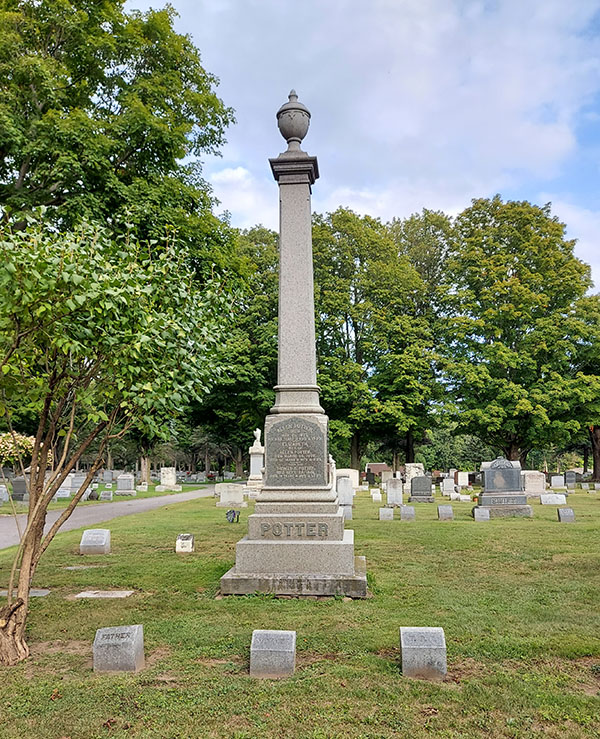
Our History
Cemetery founder Allen Potter was born June 12, 1807, in a crude hut in the wilderness which later became known as Potter’s Comers (now Orchard Park), and is thought to have been the first white child born in Erie County. His parents, Joshua Potter and Quaker Judith Palmer Potter, and his older sister, Hannah Potter (then one-year-old), had traveled by ox-drawn wagon from Danby, VT, in 1806, settling on land on present West Quaker Road.
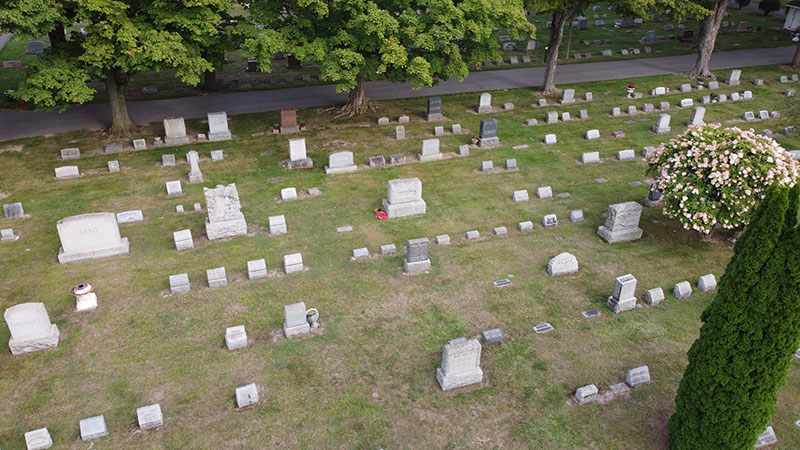
With no more education than the country schools then afforded, Allen was endowed with intelligence, strong moral fiber, and natural leadership ability. He became an entrepreneur of almost unrivaled proportions in the community. At various times he operated local mercantile enterprises and the tavern/inn (which later became the Orchard Downs), speculated in real estate, was a motivator and principal in local plank road construction and operation, served as Postmaster, Justice of the Peace, on the County Board of Supervisors and in the State Constitutional Convention of 1866, was a trustee of the Buffalo Normal School and the East Hamburgh Friends Institute, and was a director of the Manufacturers’ and Traders’ Bank of Buffalo and the Buffalo Courier Company (forerunner of the publisher of the Buffalo Courier-Express newspaper).
Early in his career, in 1832, Allen had purchased about 84 acres from his father and his father’s partner, Samuel Abbott, which included the aforementioned tavern/inn and virtually all of the land which now comprises the east half of the Village as far as a line contiguous with present Park Place, south to a line contiguous with present Thorn Avenue, and north to a line contiguous with present Taylor Road. Here he farmed, and about 1850 built the stately home which is now the Brown Funeral Home. The early development of this large portion of the Village was his to oversee, including the establishment of the Congregational (now Presbyterian) Church and the East Hamburgh Cemetery (now Woodlawn).
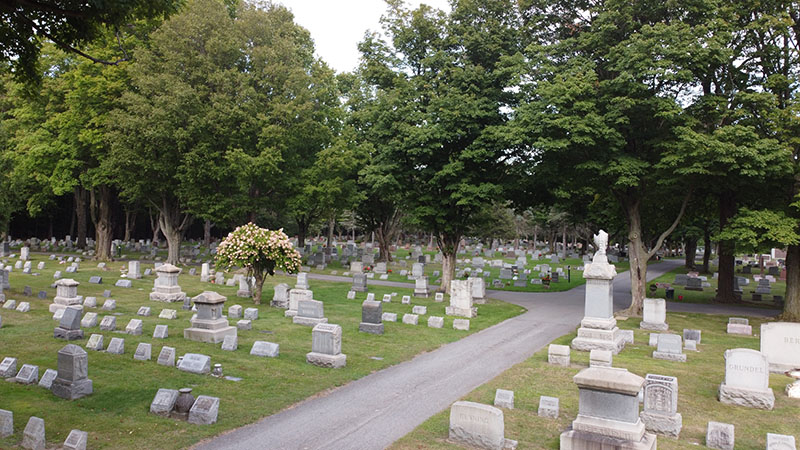
Based on the information given on grave markers, the earliest burials in the East Hamburg Cemetery date to 1851. However, there is one small stone for Frances Charlotte Abbott, a child of Chauncey and Charlotte (Brown) Abbott, who died January 8, 1848, at 3 years of age. It is in a grouping of three small stones for three of their children who died young. Chauncey Abbott’s homestead was on East Quaker Road and extended adjacent to the Allen Potter homestead. It is assumed that young Frances was originally buried on her family homestead, which was customary but was removed to the dedicated cemetery after it was established and the Abbott family purchased a family plot.
Allen Potter
No written records have been found for the first 70 years of cemetery interments. The information which has remained legible, not eroded, on the early grave markers bear the only witness to the grave occupants. It is entirely possible there were other early interments which were not marked by grave markers by the survivors. Unfortunately, this circumstance leaves questions today as to whether or not the graves are occupied, and if so, the names of the occupants. Twentieth-century cemetery personnel have probed questionable plots, but in many cases are still baffled.
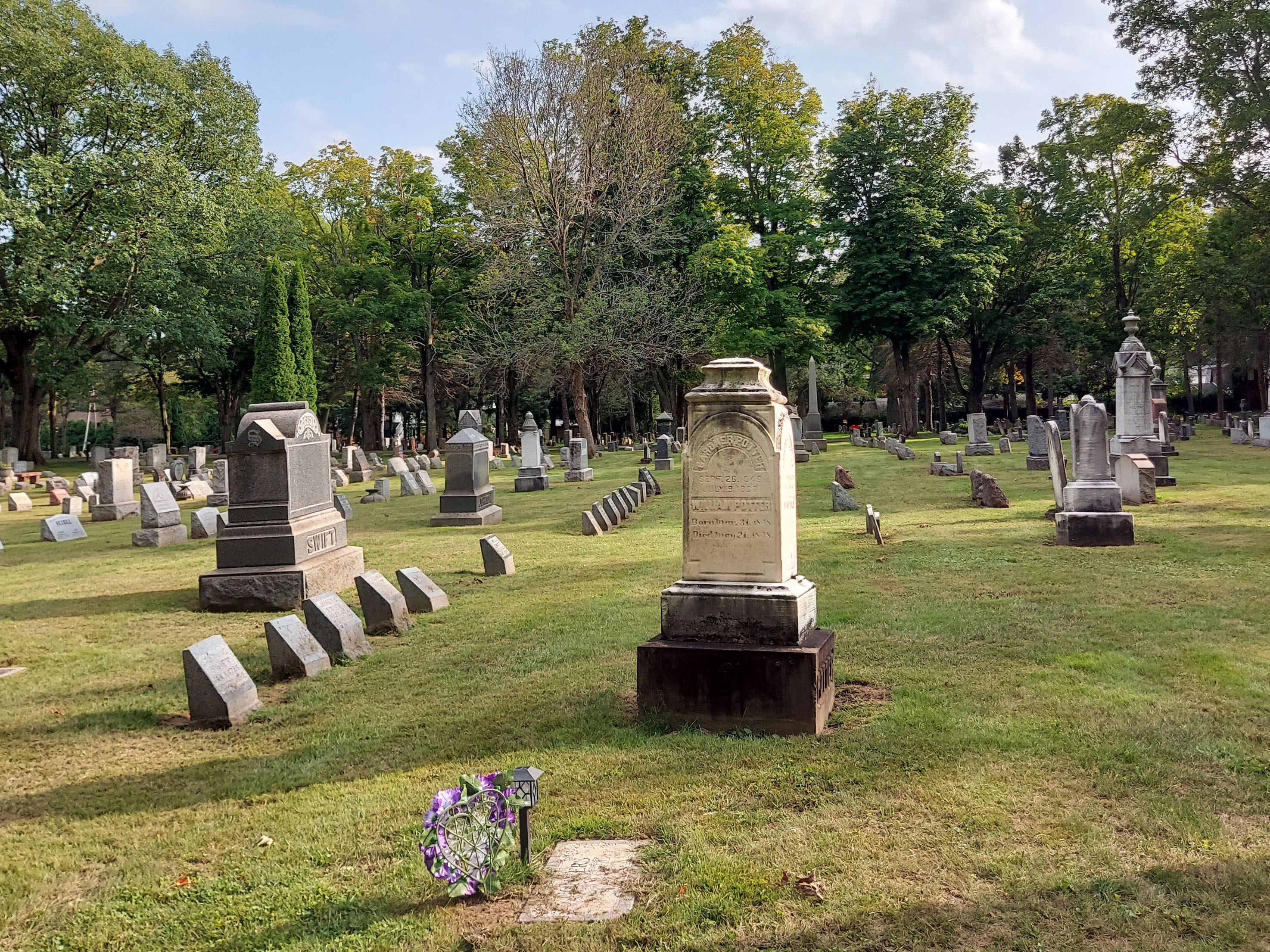
Reconstructing the origins of the East Hamburgh Cemetery, it can be shown that Allen Potter reserved a small parcel, about 2/3 acre, on the southwestern comer of his homestead for a cemetery, plus .43 acre for a 520′ long roadway to connect it to the State Highway (present South Buffalo Road). The first documentable burial was that of Mrs. Asa (Polly McClen) Trevett who died on March 6, 1851, at the age of 40, followed by Jerome Cook, son of Peter & Lydia Cook (brother of John Cook who with his son, C. Lemuel Cook became East Hamburgh’s first undertakers), who died April 4, 1851, at 15 years of age. The next burial was that of Allen & Elizabeth (Thurber) Potter’s only son, Thomas Byron Potter who died on September 22, 1851, at the age of 19. The census for the previous year, 1850, shows that Thomas had been a clerk in his father’s mercantile business in East Hamburgh. Two more interments can be documented that year: Eleanor Schermerhorn, wife of Jacob L. Schermerhorn, who died on October 10, 1851, at 86 years, and infant Frank Caswell who died on October 11, 1851, at the age of 11 months. He was the son of Alderson and Cordelia (Jones) Caswell whose 7111 Jewett-Holmwood Road home still stands, and the grandson of Ransom Jones whose historic Greek-Revival homestead also still stands at 7295 Jewett-Holmwood Road (formerly Jones Road, named for him).
On May 13, 1888, Allen Potter and his wife, Elizabeth, deeded the original cemetery land, 1 total of about 1.12 acres Including the driveway, to the trustees of the East Hamburgh Cemetery (Orson Swift, Putnam Ayers, and Ambrose C. Johnson, and their successors in office) for $150. (Erie Co. Deeds 277:445). Thus It passed from an individually owned enterprise to a trusteeship business. Together with its predecessor cemeteries, the East Hamburg Friends Cemetery and the Deuels Comers Cemetery, the small cemetery was sufficient for the rural community for many years. Indeed, it was 40 years before another acre of land was added.
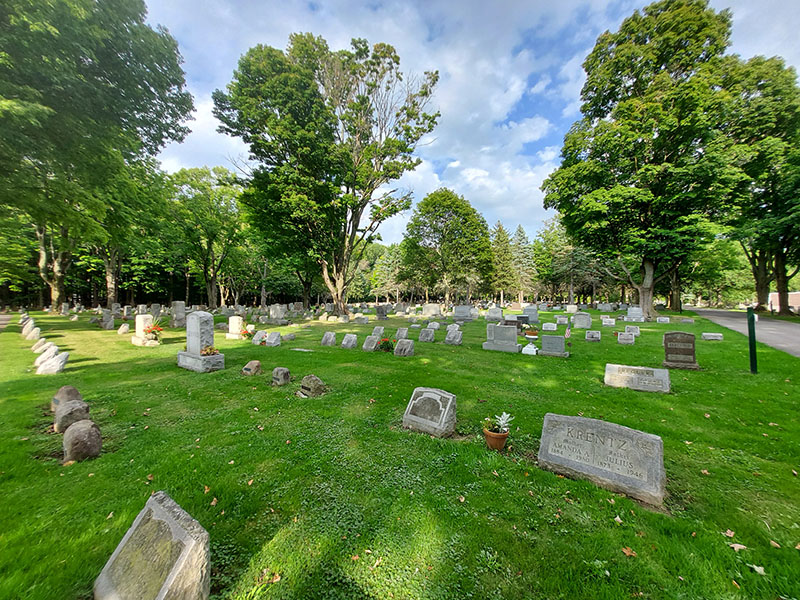
In the meantime, the Potter family had seen more tragedy. Promising young Orthodox Quaker physician Philip S. Dorland, M.D., husband of Allen and Elizabeth (Thurber) Potter’s daughter Julia Alboume Potter and son of local pioneer doctor Joseph Dorland and wife Anna (Thom), died at the age of 29 on August 15, 1866, while in Chicago, leaving his wife and a 3-year-old son, Byron A. Dorland. It was said that he was the first member of the Free and Accepted Masons to be buried in East Hamburgh; an astounding 3000 people attended the funeral. Grandfather Allen Potter assumed the role of male guardian for young Byron, overseeing his education at the East Hamburgh Friends Institute. Unfortunately, Allen was killed just 11 years later on May 31, 1877, at almost 70 years of age. The accident happened in his woods which occupied the area which has since become additional cemetery land. He and two employees, Cassius Potter and David Nye were felling a tree in order to repair a bridge on his plank road. A dislodged limb unexpectedly came down upon him, fracturing his skull. His wife, Elizabeth (Thurber) who “never entirely recovered” from his tragic death, died just ten months later, on March 20, 1878, at almost 68 years of age. A tall square column monument topped with an um marks the Potter/Dorland graves in the original part of the cemetery.
The 1880 Deed Atlas indicates Samuel McCormick resided on the two acres between the small cemetery and (present) South Buffalo Road. He conducted a “cooper shop” on the south comer of the present entrance drive to the cemetery (location of the cemetery roadside sign and plantings), and a “stave factory” across the street where Nativity of Our Lord’s church now stands. Of course, as a cooper, he made casks and barrels, and staves were a necessary part of the vessel sides.
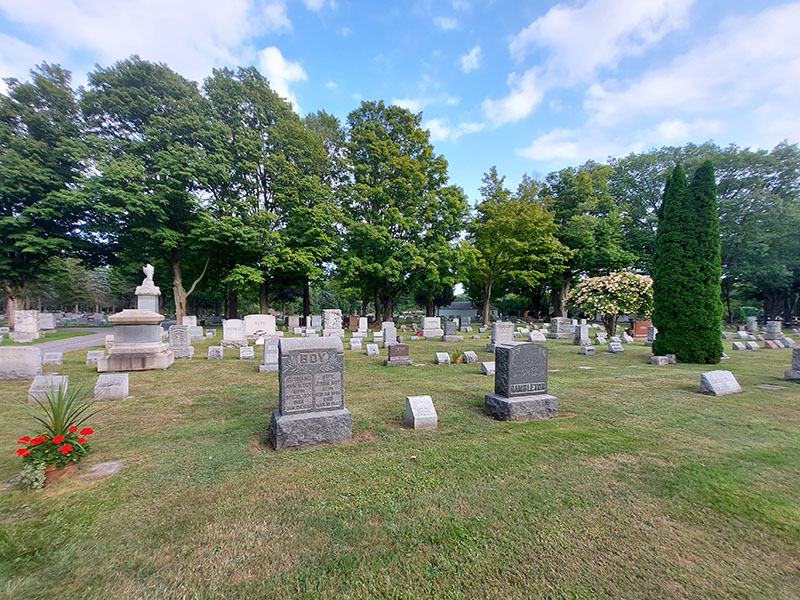 On June 8, 1891, a group of prominent male citizenry of East Hamburg met at Brigg’s Hall (Tillou’s Hall in later account) at the Wasson Hotel “for the purpose of forming an Association for the purpose of procuring and holding lands to be used exclusively fora cemetery pursuant to an act entitled ‘an Act Authorizing the Incorporation of Rural Cemetery Associations’ being Chapter 133 of the Laws of 1847, Laws of New York.” In attendance were Orson H. Godfrey, Chairman, Herbert N. Strong, Secretary, Andrew Petersen, Henry P. Anthony, Horace N. Hinman, Ambrose C. Johnson, Myron Stilwell, Gilbert Schmidt (Smith), Gilbert N. Smith, Frank M. Thom, Lobieski C. Trevett, Herbert A. Strong, Clinton N. Smith, Henry R. Mosher, Frank B. Abbott, John Cuthbert, Henry S. Schmidt (Smith), John Petz, and John C. Cook.
On June 8, 1891, a group of prominent male citizenry of East Hamburg met at Brigg’s Hall (Tillou’s Hall in later account) at the Wasson Hotel “for the purpose of forming an Association for the purpose of procuring and holding lands to be used exclusively fora cemetery pursuant to an act entitled ‘an Act Authorizing the Incorporation of Rural Cemetery Associations’ being Chapter 133 of the Laws of 1847, Laws of New York.” In attendance were Orson H. Godfrey, Chairman, Herbert N. Strong, Secretary, Andrew Petersen, Henry P. Anthony, Horace N. Hinman, Ambrose C. Johnson, Myron Stilwell, Gilbert Schmidt (Smith), Gilbert N. Smith, Frank M. Thom, Lobieski C. Trevett, Herbert A. Strong, Clinton N. Smith, Henry R. Mosher, Frank B. Abbott, John Cuthbert, Henry S. Schmidt (Smith), John Petz, and John C. Cook.
At that meeting, it was decided that the Association would be called the Woodlawn Cemetery Association of Orchard Parle (by then the Village was known as Orchard Park, but the township remained East Hamburg, losing the final “h” in its spelling). Orson H. Godfrey was elected chairman, and Gilbert N. Schmidt (Smith), Lobieski C. Trevett, Frank B. Abbott, Henry R. Mosher, Henry P. Anthony, and Herbert A. Strong, were elected Trustees.
Shortly thereafter, on September 10, 1891, the trustees of the Woodlawn Cemetery Association made the first purchase of additional land for the cemetery from the surviving daughters of Allen Potter, Alboume J. Dorland and Fannie E. Clark. For $300, they acquired approximately one acre bordering the original small plot on two sides.
This land made up a portion of what had been Allen Potter’s woods. The trustees, concerning themselves with clearing the land for cemetery use, voted on November 17, 1891, to give “William Smith the job of taking out all the trees of any size in the proposed addition to the cemetery, burning all brush and refuse, and in payment for·said work shall be entitled to all the wood from said trees.”
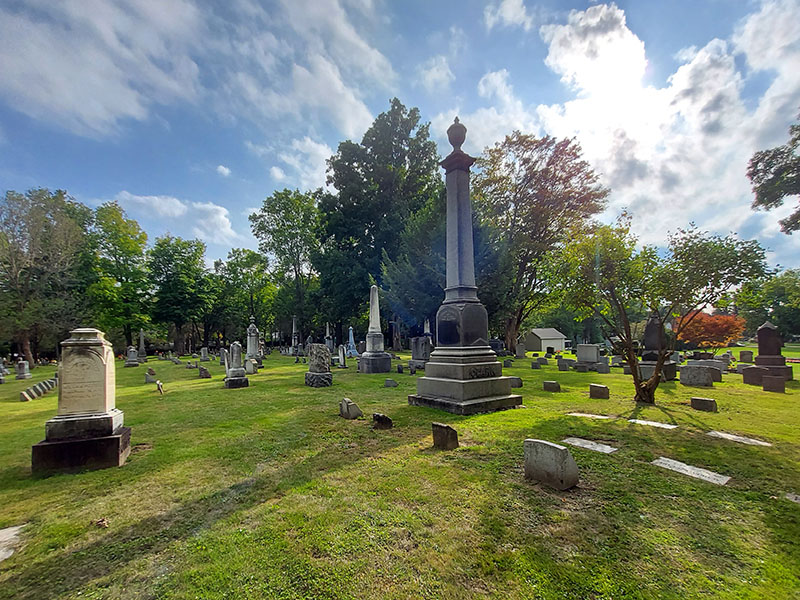
By 1898 It was determined that a “potters field” was desirable. On October 29 of that year, some lots “along the south border on the southeast comer of the cemetery” would be used as such. This would have been in the area of lots 13 in today’s Rows K, L, and M. It. is uncertain how long this specific area was in use for interments for the poor. In more modem times, ”Social Services” burials seem scattered throughout the cemetery.
Woodlawn Cemetery today covers a total of 19.82 acres. In April 1996, in response to a popular trend, a mausoleum was constructed. Interestingly, because the major portion of the cemetery is situated well away from any road, many local residents don’t realize the existence of the sizeable park-like grounds that is Woodlawn. Today it is very well maintained and a pleasant place to visit. Squirrels are forever busy scurrying and chattering, many varieties of birds fill the air with song, including a family of hawks with their loud, shrill call, and visitors and workers are coming and going constantly.
Contemplating the various grave markers and monuments, one is captivated by the stories they tell of Love: “A limitless capacity for loving and for generating love,” “True love goes on and on,” Loss: “Beloved wife; holding you I held everything,” “We never lose the ones we love,” Hope: “Together forever” and, in the case of motorcycle enthusiasts, ” ‘Till we ride together again,” and Faith “God gives us love; Someone to love he lends us.” Veterans from all U.S. Wars with the exception of the Revolutionary War are interred here. Woodlawn’s residents are a virtual “Who’s Who” of early and more recent Orchard Park.
Two ladies vie for the oldest interees:
- Augusta Hogan, widow of Christ Hogan of Seufert Road, Orchard Park who was born in 1872, and died at 105 on April 28, 1978
- Mary F. Edgerly, widow of Seward Edgerly of East Quaker Road, Orchard Park, who was born in 1884, and died at 105 on September 1, 1989
There are several stalwart individuals who were blessed with more than 100 years on our planet.
Sources: Erie County Clerk’s record of deeds; Woodlawn Cemetery Association original handwritten minutes; Woodlawn cemetery grave marker inscriptions and records; Potter family history by Suzanne S. Kulp; Beers 1880 Erie County Deed Atlas; Orchard Park Assessors Office; various Orchard Park history sources.
